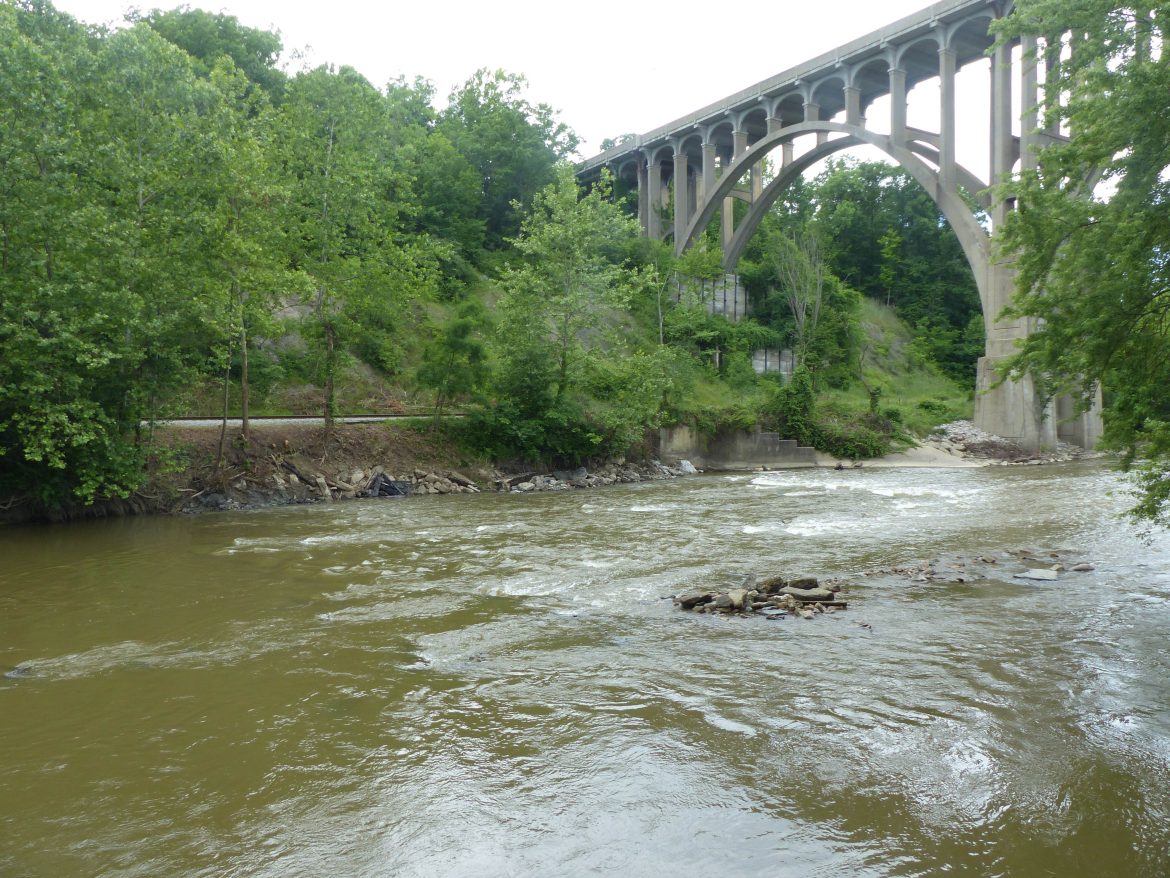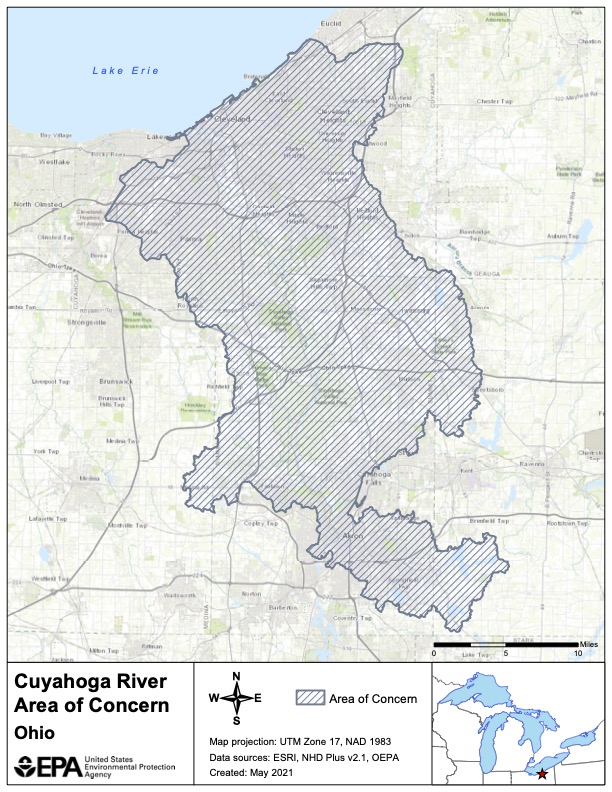
In 2002, the National Park Service removed two dams from Cuyahoga National Park at this segment of the river, Pinery Gate. Dam removal is one of many cleanup projects that can reduce solid contaminants in the river. Image: Arrye Rosser, National Park Service.
By Elinor Epperson
Fifty-five years after the Cuyahoga River last caught fire, its health continues to improve.
But determining what prevention and cleanup practices are most effective remains difficult.
The U.S. EPA recently analyzed levels of solid contaminants in the river reported over a 20-year period. It focused on areas downstream of federally funded management projects meant to reduce pollution from stormwater runoff. The authors concluded that there is less solid particulate pollution in the river than in 2000 – but were not confident they could attribute the improvement to those projects alone.
Assessing water quality is a two-step process, said Michael McManus, an EPA ecologist who coauthored the paper.
“A decreasing trend is a very positive thing to report,” he said. “The difficulty is what causes the trend.”
The researchers looked at levels of very small particles of solid matter found in water. These particles can be contaminants or carry other contaminants. They include algae, bacteria, sand, silt and gravel from a variety of natural and human sources.
They often enter waterways with rain water. Such nonpoint source pollution is human in origin, so it does not include natural runoff like dead organic matter or uncontaminated sediment.
Nonpoint source pollution is the biggest contributor to poor water quality in the United States, according to the EPA.
Governments only started addressing nonpoint source pollution in the last few decades, including northeast Ohio where Jared Bartley is the deputy director for education and watershed programs at the Cuyahoga Soil and Water Conservation District.
“Our paradigm for municipal engineering up until 20 years ago…was to get the water off the landscape as quickly as possible,” he said. “And now we’re trying to revert to keeping the water on the landscape as long as possible.”
Construction sites, urban stormwater, mining and agriculture are the largest sources of nonpoint source pollution. Most runoff entering the Cuyahoga River comes from Akron and Cleveland, bringing contaminants from residential yards, parking lots and sidewalks.
Ohio created 88 soil and water conservation districts – one for each county – in 1949 to manage and protect natural resources.
The Cuyahoga district considers itself as the first environmental organization in the county, Bartley said. Today, it is one of many organizations and government bodies that steward the river.
Reducing runoff
In 1987, Congress amended the Clean Water Act to provide funding to reduce runoff through projects like dam removal, reforestation and green infrastructure. These efforts reduce the sediment and contaminants that stormwater collects as it flows into the river.
Between 2000 and 2020, that amendment funded 21 projects in the Cuyahoga River Basin. Measuring their effectiveness is tricky.
McManus and his coauthors discovered that the biggest obstacle is the sheer number of projects in the watershed. It covers 813 square miles in six counties with dozens of city and county governments and conservation districts.
In short, there are a lot of cooks in the kitchen. Watershed planner Nichole Lopez said that’s a good thing.
“Northeast Ohio is very unique in a sense that [we] are kind of almost saturated with all these different organizations that are all working towards the same goal,” she said. “I think that’s the beauty of the Cuyahoga River. It brings all these different organizations together.”
As part of her work for the Cuyahoga Soil and Water Conservation District, Lopez works with federal, state and local stakeholders to improve the river’s health. They include the EPA, which listed the Cuyahoga as an Area of Concern in 1987 as part of the U.S.-Canada Great Lakes Water Quality Agreement.

The Cuyahoga River has been an Area of Concern in the Great Lakes region for almost 40 years. Image: United States Environmental Protection Agency.
These areas are severely polluted and require extensive remediation. Besides nonpoint source pollution, the Cuyahoga is also contaminated by pollution that entered the basin from a single source, like a factory or wastewater system.
It was this kind of pollution that caused the river to burn several times between 1868 and 1969.
Remediation of the Cuyahoga has made massive strides in the 50 years since, but the river and its ecosystem remain degraded. Current projects include restoring wetlands, building an estuary and removing the Gorge Dam and the contaminated sediment sitting behind it.
The conservation district is stabilizing streambanks, planting cover crops and teaching residents to minimize harmful runoff from their yards. The Ohio EPA has a five-year plan for addressing nonpoint source pollution. The Conservancy for Cuyahoga Valley National Park plans to restore a former golf course.
Choosing data
It was this high concentration of activity that drew McManus and his coauthors to the Cuyahoga. He referred to all those cleanup projects as “space crowding.”
“If you put in a bunch of projects together, can they sort of synergistically work to make a better restoration than having one scattered here or scattered there?” he said.
Collecting data from every project was beyond the scope of his team’s research, McManus said.
Locating water quality reports from downstream of the federally funded projects was relatively easy thanks to extensive records collected by a nearby university. McManus said he followed the available data.
“There is a strategic plan to the research,” he said. To evaluate remediation efforts in the watershed, they needed to determine where are the data and what’s available.”
Their findings confirm that space crowding has likely decreased sediment in the river – but can’t confirm how effective the Clean Water Act projects are at remediating nonpoint source pollution.
It’s difficult to track the ubiquitous nature of nonpoint source pollution, Lopez said.
“We just kind of have to hit all the bases just to make sure that we are making some progress,” she said. That means more projects from more groups — and more data to track.
Other groups addressing nonpoint source pollution can access the researchers’ data and add to it online.
“That’s one of the strengths of open science,” McManus said. “It’s sharing the data so other people [can] continue looking at trends.
“That combination of open and participatory science is what is very meaningful for people living in the watershed.”
Making the grade
While the researchers couldn’t pinpoint a best management practice or remediation effort, it is clear that cleanup is working. The nonpoint contaminants and other pollution have decreased over two decades, even as climate change has brought heavier storms that pick up more contaminants and debris.
The conservation district’s goal for the Cuyahoga is to remove the river from the EPA’s Area of Concern list. Lopez said that could happen as soon as 2030.
“We’re just trying to get it to a passing score,” Lopez said. “We don’t want it to be an F, we’re trying to get it to C, you know, Cs get degrees.”
But this is one milestone of many in the decades-long effort to improve the river’s health.
“It’s all about collaboration,” she said. “And I think we’re definitely heading in the right direction.”
Editor’s note: This story was updated May 16, 2024 to correct the number of Clean Water Act projects in the Cuyahoga River Basin.